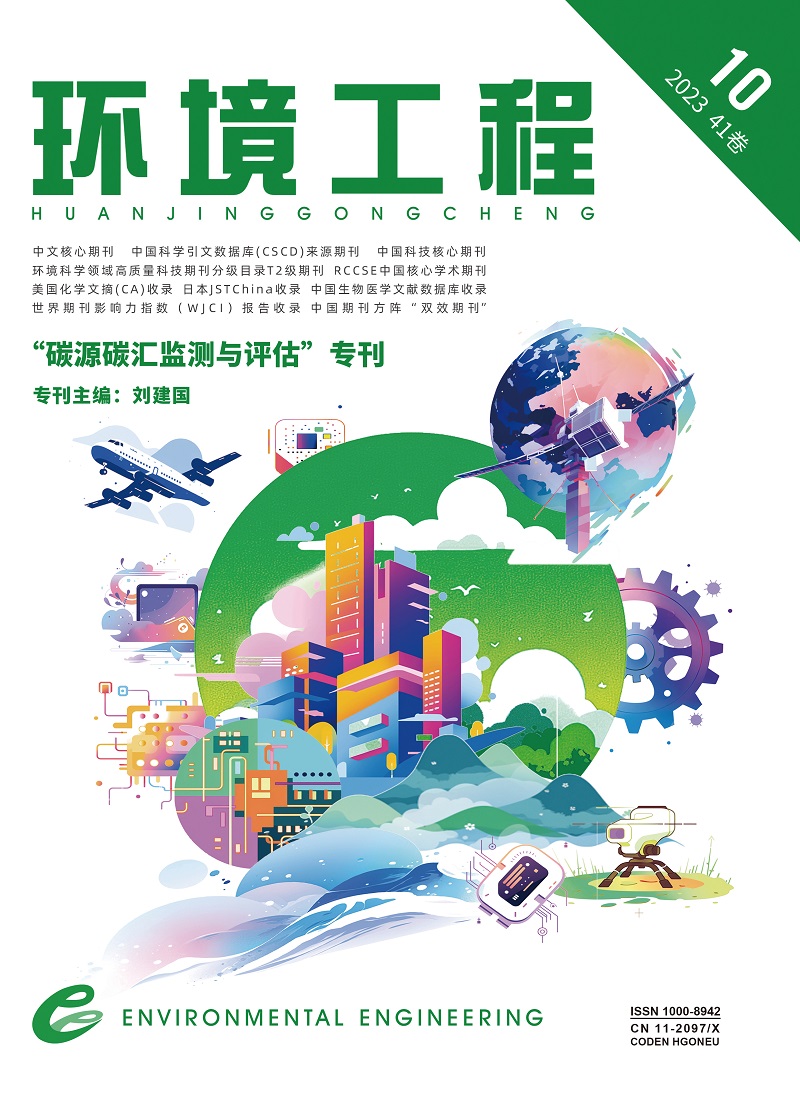| [1] |
中国气象局气候变化中心.中国气候变化蓝皮书(2022)[M].北京:科学出版社, 2022.
|
| [2] |
中华人民共和国生态环境部.减污降碳协同增效实施方案[EB/OL].https://www.mee.gov.cn/xxgk2018/xxgk/xxgk03/202206/t20220617_985879.html.2022-6-10.
|
| [3] |
江苏省人民政府.江苏省碳达峰实施方案[EB/OL].http://3060.xujc.com/2023/0221/c6642a143402/page.htm.2022-10-3.
|
| [4] |
中华人民共和国生态环境部.全国污水集中处理设施清单(第二批)[EB/OL].https://www.mee.gov.cn/xxgk2018/xxgk/xxgk01/202011/t20201123_809271.html.2020-11-17.
|
| [5] |
张星.城镇生活污水处理系统碳排放研究[D].南京:南京信息工程大学, 2018.
|
| [6] |
王金鹤.城镇污水处理厂中温室气体的释放研究[D].济南:山东大学, 2011.
|
| [7] |
邱德志, 陈纯, 郭丽, 等.基于排放因子法的中国主要城市群城镇污水厂温室气体排放特征[J].环境工程, 2022, 40(6):116-122.
|
| [8] |
闫旭, 邱德志, 郭东丽, 等.中国城镇污水处理厂温室气体排放时空分布特征[J].环境科学, 2018, 39(3):1256-1263.
|
| [9] |
张成.重庆市城镇污水处理系统碳排放研究[D].重庆:重庆大学, 2011.
|
| [10] |
任福民, 毛联华, 阜葳, 等.中国城镇污水处理厂运行能耗影响因素研究[J].给水排水, 2015, 51(1):42-47.
|
| [11] |
FOLEY J, YUAN Z, KELLER J, et al.N2O and CH4 emission from wastewater collection and treatment systems:state of the science report and technical report[M].London:IWA Publishing, 2015.
|
| [12] |
石春力, 田永英, 黄海伟, 等.我国城镇污水处理碳排放核算方法研究综述[J].建设科技, 2021(11):39-43.
|
| [13] |
TANG M G, YANG Q F, PAN C Y, et al.Driving forces of industrial water pollutant emission from spatial-dynamic perspective in china:analysis based on Kaya equation and LMDI decomposition[J].Open Journal of Social Sciences, 2019, 7(10):132-143.
|
| [14] |
齐漫, 陈昆仑, 丁镭, 等.中国省域生活废水排放量的时空分布特征及驱动因素分析[J].地理与地理信息科学, 2016, 32(4):106-112.
|
| [15] |
蔡博峰, 高庆先, 李中华, 等.中国城市污水处理厂甲烷排放因子研究[J].中国人口·资源与环境, 2015, 25(4):118-124.
|
| [16] |
李莎.城市污水四种典型处理工艺N2O排放特征的研究[D].北京:北京林业大学, 2012.
|
| [17] |
李乔洋.基于碳减排分析的我国城镇污泥处置现状及发展趋势研究[D].哈尔滨:哈尔滨工业大学, 2020.
|
| [18] |
杨世琪.城镇污水处理系统碳核算方法与模型研究[D].重庆:重庆大学, 2013.
|
| [19] |
杨淦翔, 万莉, 王航, 等.污水处理厂能耗分析及节能降耗的措施与应用[J].资源节约与环保, 2021(10):12-14.
|
| [20] |
CAKIR F Y, STENSTROM M K.Greenhouse gas production:a comparison between aerobic and anaerobic wastewater treatment technology[J].Water Res, 2005, 39(17):4197-4203.
|
| [21] |
张辰, 陈嫣, 谭学军, 等.城市污水系统温室气体排放与对策研究[J].给水排水, 2010, 46(9):29-33.
|
| [22] |
SOLOMON S.Climate change 2007:the physical science basis[M].Cambridge:Cambridge University Press, 2007.
|
| [23] |
齐香汝, 熊焱, 金文杰, 等.国内城镇污水处理能耗计算方法[J].辽宁科技大学学报, 2015, 38(2):155-160.
|
| [24] |
孙越.生活垃圾填埋气体释放特征及收集效率研究[D].沈阳:沈阳航空航天大学, 2014.
|
| [25] |
郝晓地, 涂明, 蔡正清, 等.污水处理低碳运行策略与技术导向[J].中国给水排水, 2010, 26(24):1-6.
|
| [26] |
张秀清.环境规制与碳排放量的实证分析[J].商, 2015(25):90-91.
|
| [27] |
KAYA Y.Impact of Carbon Dioxide Emission Control on GNP Growth:Interpretation of Proposed Scenarios[R].Paris:IPCC Energy and Industry Subgroup, 1989.
|
| [28] |
牟宇峰.产业转型背景下就业人口与产业发展关系研究综述[J].人口与经济, 2016(3):103-114.
|
| [29] |
ANG B W.The LMDI approach to decomposition analysis:a practical guide[J].Energ Policy, 2005, 33(7):867-871.
|
| [30] |
江苏省生态环境厅.江苏省生态环境状况公报(2001-2020年)[R].南京:江苏省生态环境厅, 2023.
|
| [31] |
苏州市生态环境局.苏州市环境状况公报(2009-2020年)[R].苏州:苏州市生态环境局, 2023.
|
| [32] |
苏州市统计局.苏州统计年鉴(2002-2021年)[M].北京:中国统计出版社, 2023.
|
| [33] |
CHEN H, YE J, ZHOU Y, et al.Environmental pollution;new findings from Shanghai academy of environmental sciences describe advances in environmental pollution (variations in CH4 and CO2 productions and emissions driven by pollution sources in municipal sewers:an assessment of the role of dissolved organic matter components and microbiota[J].Environmental Pollution, 2020, 263:114-489.
|
| [34] |
中华人民共和国生态环境部.排放源统计调查产排污核算方法和系数手册[R].北京:中华人民共和国生态环境部, 2021.
|
| [35] |
周乙新, 李激, 王燕, 等.城镇污水处理厂低浓度进水原因分析及提升措施[J].环境工程, 2021, 39(12):25-30.
|
| [36] |
王笏勇, 黄荣敏, 骆旭佳, 等.排污管网高水位运行与污水厂进水水质问题研究[C]//中国环境科学学会2021年科学技术年会, 天津, 2021.
|
| [37] |
戴永康, 罗锋, 温巧贤.东莞市城镇污水处理提质增效潜力分析[J].中国给水排水, 2020, 36(4):1-5.
|
| [38] |
卢贯能.浅淡城镇污水处理厂进水COD浓度偏低的原因[J].资源节约与环保, 2014(6):144.
|
| [39] |
林前程.污水处理厂污泥产生、处置、利用状况分析[J].科技创新导报, 2010(7):112-113.
|
| [40] |
侯爱敏, 饶郁聪.苏州高端服务业提升对策研究[J].苏州科技大学学报(工程技术版), 2022, 35(2):67-74.
|
| [41] |
苏州市统计局.苏州市第七次全国人口普查公报[R].苏州:苏州市统计局, 2021.
|
| [42] |
王晓丽.基于"IPAT"等式的城市生活污水驱动因素研究[J].生态经济, 2012(2):146-149.
|
| [43] |
卢泉, 文虎.我国省域居民消费结构变化对环境污染的影响[J].当代经济, 2010(19):85-87.
|
| [44] |
蔡博峰, 吕晨, 董金池, 等.重点行业/领域碳达峰路径研究方法[J].环境科学研究, 2022, 35(2):320-328.
|
| [45] |
刘城宇, 韩峰.生产性服务业集聚有助于降低碳排放吗?[J].南京财经大学学报, 2017(1):91-101.
|
| [46] |
陈小卉, 钟睿.江苏都市圈治理:由概念到政策[J].人类居住, 2019(2):54-57.
|


 Login
Login Register
Register E-alert
E-alert






 DownLoad:
DownLoad: